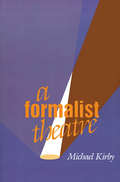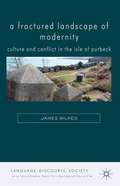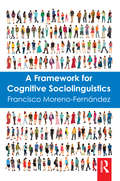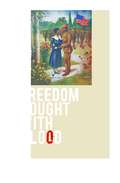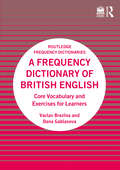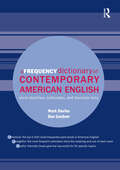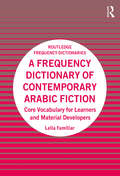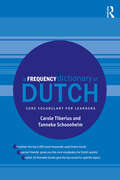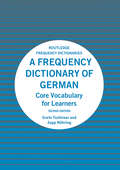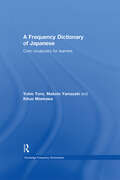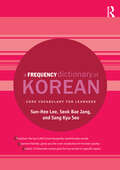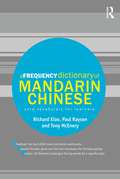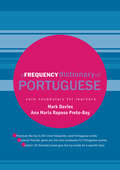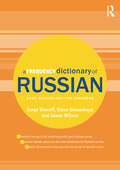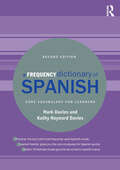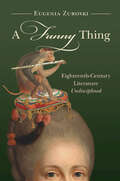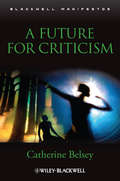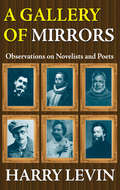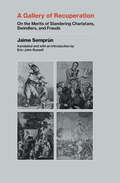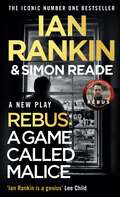- Table View
- List View
A Formalist Theatre
by Michael KirbyMichael Kirby presents a penetrating look a theater theory and analysis. His approach is analytically comprehensive and flexible, and nonevaluative. Case studies demonstrate this unique approach and record performances that otherwise would be lost.
A Fractured Landscape of Modernity
by James WilkesThis book uses the contradictions, fractures and coincidences of a twentieth-century rural landscape to explore new methods of writing place beyond 'new nature writing'. In doing so it opens up new ways of reading modernist artists and writers such as Vanessa Bell, Mary Butts and Paul Nash.
A Framework for Cognitive Sociolinguistics
by Francisco Moreno-FernandezA Framework for Cognitive Sociolinguistics attempts to lay out the epistemological system for a cognitive sociolinguistics—the first book to do so in the English language. The intention of this volume is not to provide a simple catalog of sociolinguistic principles or of theoretical postulates of a cognitive nature, but rather it aims to build a verifiable metatheoretical basis for cognitive sociolinguistics. This book is articulated through a series of propositions, accompanied by annotations and commentaries that develop, qualify and exemplify these propositions. As for the research questions that would be central to a cognitive sociolinguistic endeavor, the following incomplete catalog could be enumerated: What do speakers know about their language? What do they know about communicative interaction? What do speakers know about sociolinguistic variation? Where does that knowledge reside and how is it configured? How does social reality influence the origin and processing of language? How does language use affect the configuration, evolution and variation of language? What do speakers know about their socio-communicative context? How do speakers perceive sociolinguistic reality? What are speakers’ attitudes and beliefs regarding linguistic variation? How does sociolinguistic perception influence speakers’ communicative behavior at all levels? How does language contribute to the construction of identity? Offering a fresh perspective on the frequently taught and studied topic of cognitive linguistics, A Framework for Cognitive Sociolinguistics can easily be incorporated into existing courses in the areas of both cognitive and sociocultural linguistics.
A Freedom Bought with Blood
by Jennifer C. JamesIn the first comprehensive study of African American war literature, Jennifer James analyzes fiction, poetry, autobiography, and histories about the major wars waged before the desegregation of the U.S. military in 1948. Examining literature about the Civil War, the Spanish-American Wars, World War I, and World War II, James introduces a range of rare and understudied texts by writers such as Victor Daly, F. Grant Gilmore, William Gardner Smith, and Susie King Taylor. She argues that works by these as well as canonical writers such as William Wells Brown, Paul Laurence Dunbar, and Gwendolyn Brooks mark a distinctive contribution to African American letters.In establishing African American war literature as a long-standing literary genre in its own right, James also considers the ways in which this writing, centered as it is on moments of national crisis, complicated debates about black identity and African Americans' claims to citizenship. In a provocative assessment, James argues that the very ambivalence over the use of violence as a political instrument defines African American war writing and creates a compelling, contradictory body of literature that defies easy summary.
A Frequency Dictionary of British English: Core Vocabulary and Exercises for Learners (Routledge Frequency Dictionaries)
by Vaclav Brezina Dana GablasovaA Frequency Dictionary of British English provides information about the frequency and distribution of words in British English. The dictionary presents rich information about word frequencies and distributions in an accessible manner. In addition to textual and numerical information, the dictionary offers a range of visualisations to help understand the statistical properties of words. These visualisations are especially important for pedagogical uses of the book. This book also includes vocabulary exercises for learners of English to activate their vocabulary with the help of the dictionary. The dictionary is based on extensive research on current British English using the British National Corpus 2014, a 100-million-word corpus of contemporary British English developed at Lancaster University. The corpus represents a wide range of genres/registers of spoken and written English, including informal speech, fiction, newspapers, academic writing and e-language. Additional support materials for this book are available at https://lancslex.lancs.ac.uk This dictionary is designed to meet the needs of a wide variety of users interested in current British English vocabulary including students, educators, journalists, material developers and researchers.
A Frequency Dictionary of Contemporary American English: Word Sketches, Collocates and Thematic Lists (Routledge Frequency Dictionaries)
by Mark Davies Dee GardnerFirst published in 2010 . Routledge is an imprint of Taylor & Francis, an informa company.
A Frequency Dictionary of Contemporary Arabic Fiction: Core Vocabulary for Learners and Material Developers (Routledge Frequency Dictionaries)
by Laila FamiliarA Frequency Dictionary of Contemporary Arabic Fiction provides a list of the top 2,000 words occurring in contemporary Arabic fiction. Based on a written corpus that contains 144 literary samples, the dictionary addresses key areas of Arabic language learning and teaching, including lexical frequency, reading skills, and Arabic literature. Each entry in the main frequency index includes a sample sentence, English translation, and frequency indicator, and alphabetical and part-of-speech indexes are provided for ease of use. The dictionary also contains 19 thematically organized and frequency-ranked lists of words on a variety of topics, such as food, places, emotions, and nature. Engaging and highly useful, this Frequency Dictionary is a valuable resource for students and instructors working in the area of TAFL, and for applied linguists interested in Arabic corpus linguistics.
A Frequency Dictionary of Czech: Core Vocabulary for Learners (Routledge Frequency Dictionaries)
by František Cermák Michal KrenA Frequency Dictionary of Czech is an invaluable tool for all learners of Czech, providing a list of the 5,000 most frequently used words in the language. Based on data from a 100 million word corpus and evenly balanced between spoken, fiction, non-fiction and newspaper texts, the dictionary provides the user with a detailed frequency-based list, as well as alphabetical and part of speech indexes. All entries in the rank frequency list feature the English equivalent, a sample sentence with English translation and an indication of register variation. The dictionary also contains twenty thematically organised and frequency-ranked lists of words on a variety of topics, such as family, food and drink and transport. A Frequency Dictionary of Czech enables students of all levels to get the most out of their study of vocabulary in an engaging and efficient way. It is also a rich resource for language teaching, research, curriculum design, and materials development. A CD version is available to purchase separately. Designed for use by corpus and computational linguists it provides the full text in a format that researchers can process and turn into suitable lists for their own research work.
A Frequency Dictionary of Dutch: Core Vocabulary for Learners (Routledge Frequency Dictionaries)
by Carole Tiberius Tanneke SchoonheimA Frequency Dictionary of Dutch is a valuable tool for all learners of Dutch, providing a list of the 5,000 most frequently used words in the language. Based on a 290 million word corpus which includes both written and spoken material from a wide range of sources, this dictionary presents Dutch core vocabulary in a detailed and clearly arranged manner: each of the 5,000 entries includes English equivalents and a sample sentence showing language in use. Users can access the top 5,000 words either through the main frequency listings or an alphabetical index. Throughout the frequency listings there are thematically organized lists featuring the top words from a variety of key topics such as animals, food and other areas of daily and cultural life. Words specific to Dutch in Belgium (Belgian Dutch) are also included. An engaging and efficient resource, A Frequency Dictionary of Dutch will enable students of all levels to get the most out of their study. This book was prepared in association with the Instituut voor Nederlandse Lexicologie (INL, Institute of Dutch Lexicology). A CD version is available to purchase separately. Designed for use by corpus and computational linguists, it provides the full text in a format that researchers can process and turn into suitable lists for their own research purposes.
A Frequency Dictionary of French: Core Vocabulary for Learners (Routledge Frequency Dictionaries)
by Deryle Lonsdale Yvon Le BrasA Frequency Dictionary of French is an invaluable tool for all learners of French, providing a list of the 5000 most frequently used words in the language. Based on a 23-million-word corpus of French which includes written and spoken material both from France and overseas, this dictionary provides the user with detailed information for each of the 5000 entries, including English equivalents, a sample sentence, its English translation, usage statistics, and an indication of register variation. Users can access the top 5000 words either through the main frequency listing or through an alphabetical index. Throughout the frequency listing there are thematically-organized lists of the top words from a variety of key topics such as sports, weather, clothing, and family terms. An engaging and highly useful resource, the Frequency Dictionary of French will enable students of all levels to get the most out of their study of French vocabulary. Deryle Lonsdale is Associate Professor in the Linguistics and English Language Department at Brigham Young University (Provo, Utah). Yvon Le Bras is Associate Professor of French and Department Chair of the French and Italian Department at Brigham Young University (Provo, Utah).
A Frequency Dictionary of German: Core Vocabulary for Learners (Routledge Frequency Dictionaries)
by Erwin Tschirner Jupp MöhringThis completely updated edition of A Frequency Dictionary of German contains the 5,000 most commonly used words of German today, occurring in a 20 million word corpus (compared to a 4.2 million corpus in the first edition). The basis of the frequency list is a significantly extended version of the Herder/BYU Corpus of Contemporary German. The Dictionary contains spoken and written German, and represents different genres, text types, registers, styles, and also regional varieties. The corpus is designed to represent the current German language as it is used in real world. Useful as a reference for students and course designers alike, A Frequency Dictionary of German is an important new resource.
A Frequency Dictionary of Japanese (Routledge Frequency Dictionaries)
by Yukio Tono Makoto Yamazaki Kikuo MaekawaA Frequency Dictionary of Japanese is an invaluable tool for all learners of Japanese, providing a list of the 5,000 most commonly used words in the language. Based on a100 million word corpus, composed of spoken, fiction, non-fiction and news texts in current use, the dictionary provides the user with a detailed frequency-based list, as well as alphabetical and part-of-speech indices. All entries in the frequency list feature the English equivalent and a sample sentence with English translation. The dictionary also contains 25 thematically organised lists of frequently used words on a variety of topics such as food, weather, occupations and leisure. Numerous bar charts are also included to highlight the phonetic and spelling variants across register. A Frequency Dictionary of Japanese enables students of all levels to maximise their study of Japanese vocabulary in an efficient and engaging way. It is also an excellent resource for teachers of the language.
A Frequency Dictionary of Korean: Core Vocabulary for Learners (Routledge Frequency Dictionaries)
by Sun-Hee Lee Seok Bae Jang Sang Kyu SeoA Frequency Dictionary of Korean is an invaluable tool for all learners of Korean, providing a list of the 5000 most frequently used words in the language. Based on the Sejong National Corpora, the largest written and spoken corpora in Korean comprised of 10 million words collected from different genres, the Dictionary provides the user with detailed information for each of the entries, including illustrative examples and English translations. The Dictionary provides a rich resource for language teaching and curriculum design, while a separate CD version provides the full text in a tab-delimited format ideally suited for use by corpus and computational linguists. With entries arranged both by frequency and alphabetically, A Frequency Dictionary of Korean enables students of all levels to get the most out of their study of vocabulary in an engaging and efficient way.
A Frequency Dictionary of Mandarin Chinese: Core Vocabulary for Learners (Routledge Frequency Dictionaries)
by Richard Xiao Paul Rayson Tony McEneryA Frequency Dictionary of Mandarin Chinese is an invaluable tool for all learners of Mandarin Chinese, providing a list of the 5,000 words and the 2,000 Chinese characters (simplified) most commonly used in the language. Based on a fifty-million-word corpus composed of spoken, fiction, non-fiction and news texts in current use, the dictionary provides the user with a detailed frequency-based list, as well as alphabetical and part-of-speech indexes. All entries in the frequency list feature the English equivalent and a sample sentence with English translation. The Dictionary also contains thirty thematically organized lists of frequently used words on a variety of topics such as food, weather, travel and time expressions. A Frequency Dictionary of Mandarin Chinese enables students of all levels to maximize their study of Mandarin vocabulary in an efficient and engaging way. It is also an excellent resource for teachers of the language. A CD version is available to purchase separately. Designed for use by corpus and computational linguists it provides the full text in a format that researchers can process and turn into suitable lists for their own research work.
A Frequency Dictionary of Portuguese (Routledge Frequency Dictionaries)
by Mark Davies Ana Maria Preto-BayAn invaluable tool for learners of Portuguese, this Frequency Dictionary provides a list of the 5000 most commonly used words in the language. Based on a twenty-million-word collection of Portuguese (taken from both Portuguese and Brazilian sources), which includes both written and spoken material, this dictionary provides detailed information for each of the 5000 entries, including the English equivalent, a sample sentence, and an indication of register and dialect variation. Users can access the top 5000 words either through the main frequency listing or through an alphabetical index. Throughout the frequency listing there are also thrity thematically-organized ‘boxed’ lists of the top words from a variety of key topics such as sports, weather, clothing and relations. An engaging and highly useful resource, A Frequency Dictionary of Portuguese will enable students of all levels to get the most out of their study of Portuguese vocabulary. Former CD content is now available to access at www.routledge.com/9780415419970 as support material. Designed for use by corpus and computational linguists it provides the full text in a format that researchers can process and turn into suitable lists for their own research work.
A Frequency Dictionary of Russian: core vocabulary for learners (Routledge Frequency Dictionaries)
by James Wilson Serge Sharoff Elena UmanskayaA Frequency Dictionary of Russian is an invaluable tool for all learners of Russian, providing a list of the 5,000 most frequently used words in the language and the 300 most frequent multiword constructions. The dictionary is based on data from a 150-million-word internet corpus taken from more than 75,000 webpages and covering a range of text types from news and journalistic articles, research papers, administrative texts and fiction. All entries in the rank frequency list feature the English equivalent, a sample sentence with English translation, a part of speech indication, indication of stress for polysyllabic words and information on inflection for irregular forms. The dictionary also contains twenty-six thematically organised and frequency-ranked lists of words on a variety of topics, such as food and drink, travel, and sports and leisure. A Frequency Dictionary of Russian enables students of all levels to get the most out of their study of vocabulary in an engaging and efficient way. It is also a rich resource for language teaching, research, curriculum design, and materials development. A CD version is available to purchase separately. Designed for use by corpus and computational linguists it provides the full text in a format that researchers can process and turn into suitable lists for their own research purposes.
A Frequency Dictionary of Spanish: Core Vocabulary for Learners (Routledge Frequency Dictionaries Ser.)
by Mark Davies Kathy Hayward DaviesA Frequency Dictionary of Spanish has been fully revised and updated, including over 500 new entries, making it an invaluable resource for students of Spanish. Based on a new web-based corpus containing more than 2 billion words collected from 21 Spanish-speaking countries, the second edition of A Frequency Dictionary of Spanish provides the most expansive and up-to-date guidelines on Spanish vocabulary. Each entry is accompanied with an illustrative example and full English translation. The Dictionary provides a rich resource for language teaching and curriculum design, while a separate CD version provides the full text in a tab-delimited format ideally suited for use by corpus and computational linguistics. With entries arranged both by frequency and alphabetically, A Frequency Dictionary of Spanish enables students of all levels to get the most out of their study of vocabulary in an engaging and efficient way.
A Functional Linguistic Perspective on Developing Language (Routledge Advances in Functional Linguistics)
by Anne McCabeThis volume offers a comprehensive account of language development from a Systemic Functional Linguistic (SFL) perspective, integrating theory and data from a wide range of research studies. The book begins by taking an in-depth look at SFL theory and its focus on texts, highlighting the metafunctional nature of language and the ways in which individuals’ repertoires of meaning-making resources develop as they interact with the world and with others. Grounded in an SFL approach, the successive chapters consider in turn the key stages of language development, from infancy to school settings to additional, second, and foreign language learning contexts. Each chapter incorporates a range of SFL studies to demonstrate shifts in language development across these stages, but also the discussion of other functional perspectives to examine the ways in which these different approaches inform one another. A concluding chapter considers the implications of these studies for future research as well as for pedagogical practices in literacy teaching. In its consideration of the relationship between SFL theory and its application to language development, this book will be key reading for students and scholars in Systemic Functional Linguistics, language and education, and literacy studies.
A Funny Thing: Eighteenth-Century Literature Undisciplined
by Eugenia ZuroskiEighteenth-century literature is weirder than we realize. A Funny Thing invites readers to be taken by its oddities, its silliness, and its absurdities – both because reading this way is fun, and because this challenges colonialism's disciplinary epistemes of propriety that have consistently bound liberal selfhood to extractive capitalism. Focusing on three aesthetic modes largely unnamed in existing studies of the period's literature – the anamorphic, the ludic, and the orificial – this book offers fresh readings of work by Haywood, Walpole, Bentley, and Burney that point to unexpected legacies from the so-called Age of Reason. This book is for any reader curious about the wilder flights of fancy in eighteenth-century fiction, the period's queer sense of humour, and how writing and art of the time challenge colonial reality. This title is part of the Flip it Open Programme and may also be available Open Access. Check our website Cambridge Core for details.
A Future for Criticism (Wiley-blackwell Manifestos Ser. #40)
by Catherine BelseyA Future for Criticism considers why fiction gives so much pleasure, and the neglect of this issue in contemporary criticism. Offers a brief, lively, and accessible account of a new direction for critical practice, from one of Britain's most prominent literary theorists and critics Proposes a new path for future criticism, more open to reflecting on the pleasures of fiction Written in a clear, jargon-free style, and illustrated throughout with numerous examples
A Gallery of Mirrors: Observations on Novelists and Poets
by T. TregearThe essays in this classic volume range from broad concerns with critical theory and aesthetic formulation to specific analysis of forms and texts. Levin discusses such matters as the symbolic interpretation of literature, the development of literary criticism during the past half-century, European attitudes toward contemporary American writers, and re-evaluations of Joyce, Proust, Balzac, Cervantes, Melville, and Hemingway. Because Levin is both a learned scholar and imaginative critic, there is no comparable book that offers the wit, taste, and learning one finds in these pages. His historical and comparative approaches to literary theory enable Levin to place a given work precisely by relating it to other works and manifestations of culture. World literature is not the province of this work. But Levin views it as the horizon against which our own traditions may be measured. Just as anthropologists discover similar processes working through diverse cultures, so through can we glean understanding of common patterns through the analysis of world literature, our own peculiarly specialized branch of the science of man. The effect of convention, in shaping the extent to which literature may be conceived as an institution, has been widely discussed. A Gallery of Mirrors raises theoretical questions that touch the methodology of humanistic scholarship, with regard to other disciplines, and the status of art, with regard to other modes of knowledge. With changing schools of critical thought, Levin relies considerably on semantics as a precision instrument for defining concepts in the terms of those for whom they were most meaningful.
A Gallery of Recuperation: On the Merits of Slandering Charlatans, Swindlers, and Frauds
by Jaime SemprunThe first English translation of the French cult classic that lampoons France&’s most popular intellectuals of the post-1968 period and their ideas, which became forces of counterrevolution.Eric-John Russell&’s translation of Jaime Semprún&’s brutal takedown of France&’s best-known intellectuals of the post-1968 period, A Gallery of Recuperation, is one of the first full English versions of any of Semprún&’s books. Originally titled Précis de recuperation, the book is a scathing critique of ten major thinkers, including Michel Foucault, Gilles Deleuze, Jean-François Lyotard, and Cornelius Castoriadis. Semprún uses this catalog of careerism to reflect on the concept of recuperation—capitalism&’s uncanny ability to coopt anticapitalist critiques and subvert subversion. His central question: What happens to revolutionary ideas, including Marxism itself, in the hands of professional intellectuals?Semprún&’s idiosyncratic and playful style of polemics takes existentialism, humanism, structuralism, poststructuralism, postmodernism, aesthetics, and psychoanalysis to task, casting new light on the figures who have become dominant staples of modern Anglophone academia, and proving the necessity of critiquing intellectuals&’ roles within contemporary capitalism. A cult classic among the French radical left and scholars of the Situationist International and May 1968, A Gallery of Recuperation never made the impact it should have. Russell&’s translation marks a major step in recognizing Semprún&’s work beyond its French context.
A Game Called Malice: A Rebus Play
by Ian Rankin Simon ReadeA delicious, and somewhat drunken, dinner party segues into a murder mystery game created by the hostess. However, the parlour game may hold clues about the dark truths hiding just under the surface of this genteel gathering...As suspects, clues and red herrings are sifted - it seems one of the guests has an unfair advantage: John Rebus, an ex-detective who used to do this for a living. But is he playing another game, one to which only he knows the rules, that will soon be revealed? As the tension rises, one by one, all their secrets will come out - and there is a shocking discovery that awaits them all...
A Game Called Malice: A Rebus Play
by Ian Rankin Simon ReadeA delicious, and somewhat drunken, dinner party segues into a murder mystery game created by the hostess. However, the parlour game may hold clues about the dark truths hiding just under the surface of this genteel gathering...As suspects, clues and red herrings are sifted - it seems one of the guests has an unfair advantage: John Rebus, an ex-detective who used to do this for a living. But is he playing another game, one to which only he knows the rules, that will soon be revealed? As the tension rises, one by one, all their secrets will come out - and there is a shocking discovery that awaits them all...
A Garland Of Prose
by A. K. C. PanikkarThis anthology has been conceived as a collection of some of the most readable specimens of English prose. Cobbett and Goldsmith wrote a couple of centuries ago, but they are perhaps closer to the Indian mind than many writers of this century.
